Outforia Quicktake: Key Takeaways
- Owls, known as opportunistic carnivores, have varied diets depending on their habitats, including rodents, fish, insects, ducks, invertebrates, and scavenger food.
- While all owls share certain hunting techniques, such as silent flight and unique predatory specializations, their methods and prey can vary significantly, from the fish-eating Blakiston’s Fish Owl to the insectivorous Burrowing Owl.
- Owls swallow their food whole or in large chunks due to their inability to chew. They have two stomachs, one for separating digestible and indigestible parts and another to grind up the meat for nutrient absorption.
- Owl species show strong adaptation to their environments, both in their hunting techniques and in their physical characteristics, such as camouflage and silent flight abilities.
- The diet and hunting habits of owls play a significant role in ecosystem balance, as they help control pest populations.
With over 200 species of owls spread across the world and 19 of those alone in North America, there’s a lot of variety in their diet.
Of course, what’s on an owl’s menu depends greatly on the area where they live. But no matter what kind of habitat they call home, all owls are opportunistic carnivores.
This means that not only do some owls take advantage of their unique physiology to hunt soundlessly, but they are also scavengers.
Owls are magnificent birds of prey that are found in a wide variety of habitats all over the world. This includes deserts, prairies, and even the Arctic tundra!
They are known for their distinctive calls and nocturnal hunting habits, which have made them the subject of many myths and legends. Let’s take a closer look at these fascinating creatures and answer the question, “What do owls eat?”
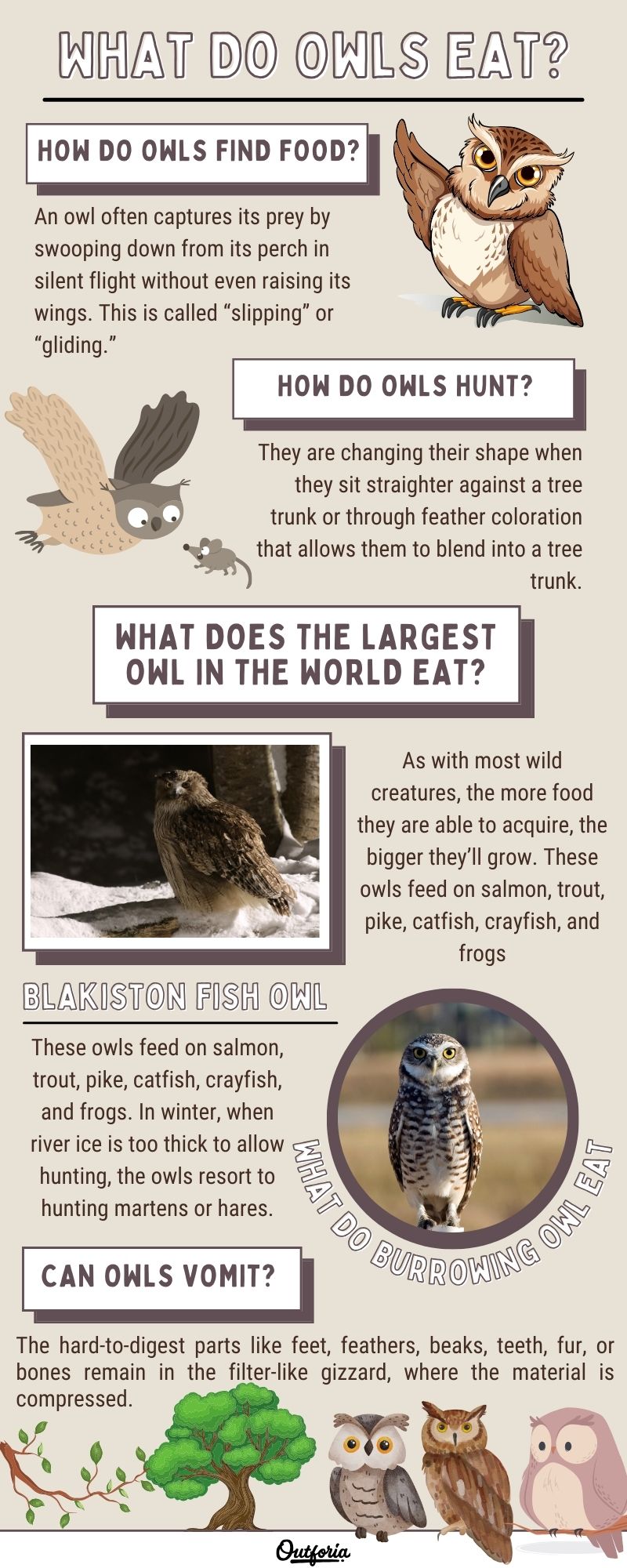
Share This Image On Your Site
<a href="https://outforia.com/what-do-owls-eat/"><img style="width:100%;" src="https://outforia.com/wp-content/uploads/2023/10/what-do-owls-eat-infographics-1.jpg"></a><br>What do owls eat Infographic by <a href="https://outforia.com">Outforia</a>What is an Owl’s Diet?
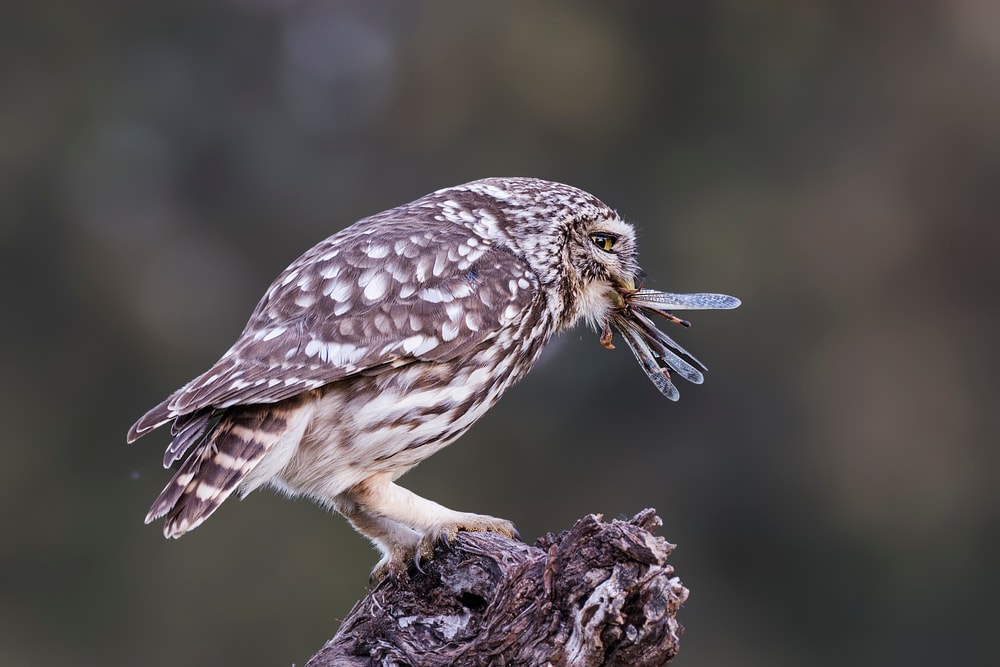
Owls are known to eat rodents such as mice, voles, and lemmings, but they also eat fish, insects, ducks, invertebrates, and even roadkill. They’ve also been seen feeding on carrion that other animals have killed.
They aren’t proud, and it’s tough to survive in a world of ever-diminishing habitat. Wild animals everywhere, including owls, must eat when they can or starve.
Migrating for food
Some species of owls have been known to stay with the same mate for up to 8 years and use the same nesting location. Some species of owls migrate to warmer places in the winter, but the majority do not.
Snowy owls are an exception because they must migrate to follow their food as they migrate to slightly warmer places for survival. They must be willing to relocate wherever there is prey.
The snowy owl, also called the Arctic owl, feeds primarily on small mammals and ducks when it can. It prefers lemmings, but if they aren’t available, the owl will also eat voles, ground squirrels, rabbits, ducks, and geese if it can get them.
The snowy owl has also been seen scavenging hoofed carrion, such as reindeer.
How Do Owls Find Food?

An owl often captures its prey by swooping down from its perch in silent flight without even raising its wings. This is called “slipping” or “gliding.”
The owl may also pursue its prey while flying quickly and continuously pounding its wings. Occasionally, the owl will simply run after its prey.
The wallop, in which the owl falls directly on its target and grabs it with its talons, is the most typical form of capture. Sometimes it will engage in an acrobatic maneuver known as the sweep, flying low and seizing its prey in the talons of one foot.
You May Also Like: Can Ducks Fly? How Do They Do It? Unlocking The Secrets Of Duck Flight
How Do Owls Hunt?

An owl’s “edge” in hunting is a result of unique and distinct specializations. These are features such as silent flight, facial disks, asymmetrical or uneven ears, and large forward-facing eyes.
The presence of extra bones in its neck allows the owl to turn its head up to 270 degrees, giving it a more complete image of its environment.
The design features of an owl’s wing feathers enable silent flight. Serrations at the leading edge of the wing and a velvety dorsal surface of each feather allow the owl to swoop ghost-like from its hiding spot.
“Fringes” on the trailing edges of the wings reduce fluttering noises, making an owl even more silent.
The only owls on which these feather specializations are seen are fish-eating owls, which do not depend on silent flight for capturing their prey.
Part of an owl’s success at hunting comes from knowing its hunting range exceedingly well. Success at hunting means better odds of survival.
Where it can hide, the movement patterns of prey, and where they congregate all contribute to increased success at finding food. This results in healthier chicks.
Camouflage techniques
Owls are masters at blending into their environment. They do this by changing their shape when they sit straighter against a tree trunk or through feather coloration that allows them to blend into a tree trunk.
Some species of owls have tufts of feathers atop their heads that resemble small branches, allowing them to look even more like part of a tree.
This not only prevents their prey from spotting them, but this adaptation also prevents other birds from raising the alarm that an owl is near. This translates into more successful hunts.
So you can see how specialization influences the odds of survival, despite their shrinking habitat and food sources.
How Do Owls Eat?
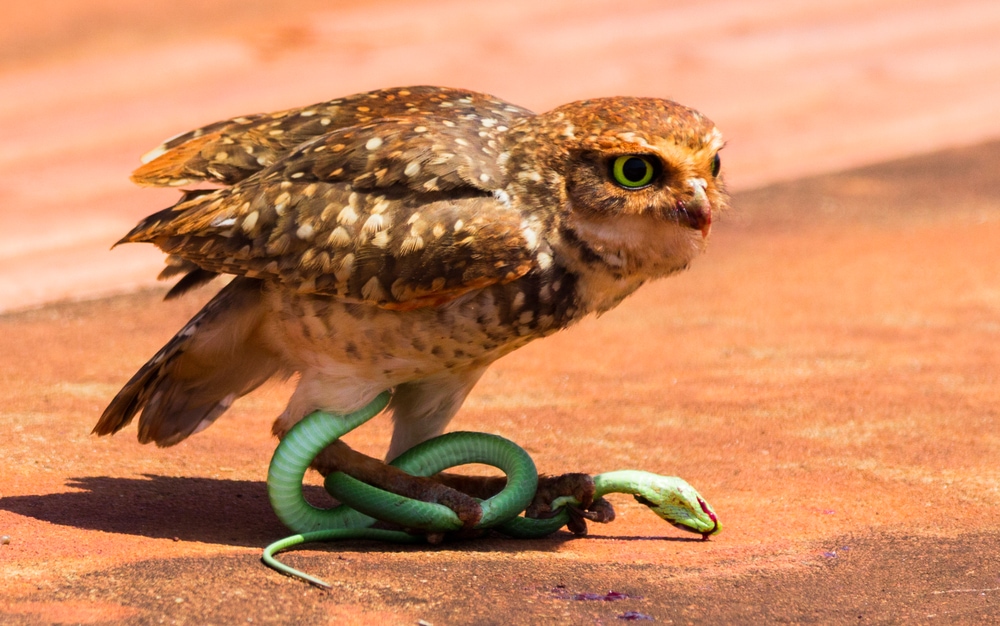
Because owls cannot chew their food, they swallow it whole, or if it is larger than a vole or mouse, they will rip the prey into chunks that can be easily swallowed. But their digestive systems are unlike ours in that they have two stomachs.
One is called the glandular stomach or proventriculus. It produces acids that separate the indigestible from digestible parts of the owl’s meal.
The second stomach is called the gizzard or ventriculus, and it is here that the meat is ground up by muscular contractions.
These soft parts move along into the bird’s intestine for nutrient absorption, aided by digestive enzymes secreted by the liver and pancreas.
Owls with Special Hunting Techniques
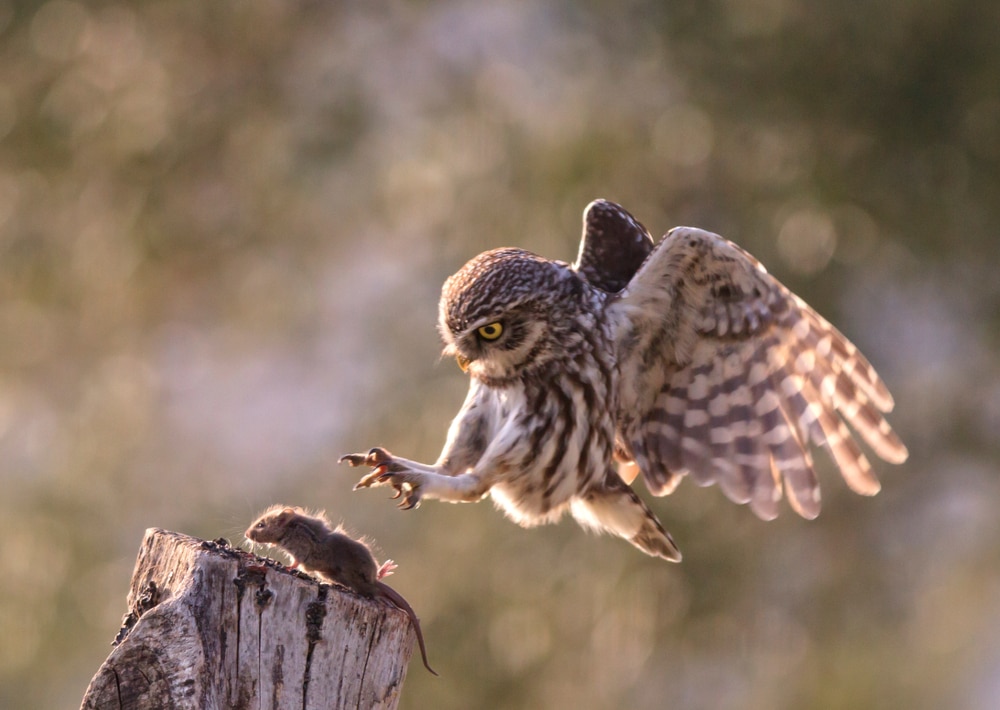
However, not all owls have a recessed facial disk, which results in less-than-exceptional hearing. One such owl is the endangered Blakiston’s Fish Owl.
Because they don’t need to hunt nearly silent prey, they don’t need such specialized body modifications, including feather serrations.
So, while a Great Horned Owl can fly noiselessly, the Blakiston cannot. They are remarkable hunters who settle on a rock in a river or in a spot on the riverside where fish gather. They can also swoop down from the air and snatch a fish from the water while in flight.
These owls have also been observed to simply walk down to a riverbank, find a prospective-looking pool, and hunt there.
Once they have found a good fishing spot, they can haul in fish up to three times larger than themselves.
While their forest-dwelling cousins do not need to be as strong, the stronger the individual Blakiston, the more food they can catch. But as with other owl species, they do find more success hunting both at dusk and at night under the cover of darkness.
You May Also Like: Are Birds Mammals? The Difference Between Feathers & Fur
What Does the Largest Owl in the World Eat?
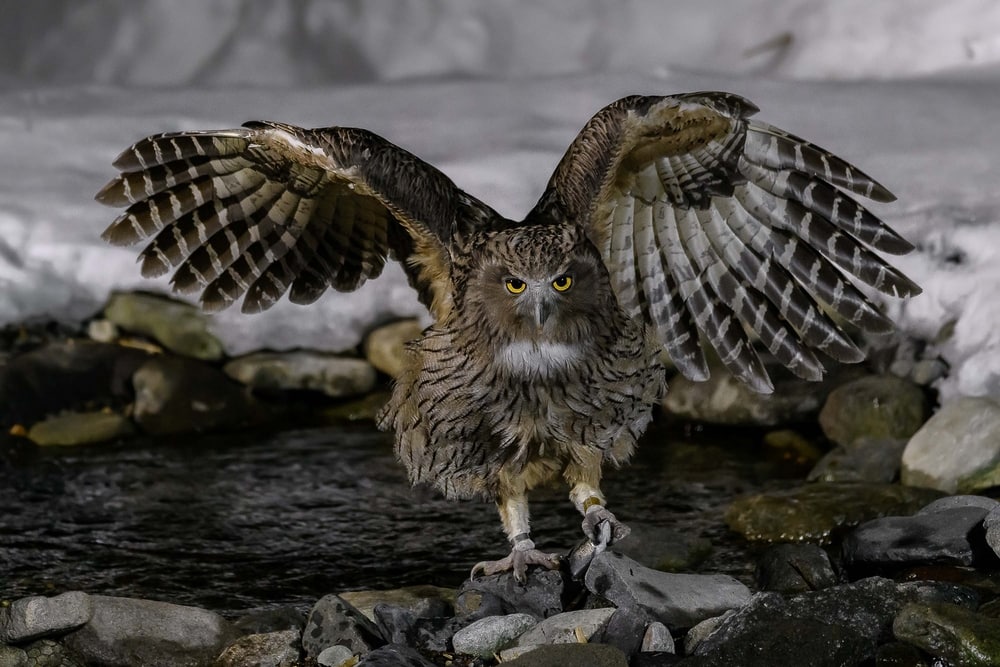
The Blakiston fish owl, named for the English naturalist Thomas Blakiston, who found the first specimen on Hokkaido in 1883, is the world’s largest owl, outweighing even the Eurasian owl.
As with most birds of prey, the female is larger than the male, averaging a weight of 7 pounds (3.25 kg). The heaviest recorded Blakiston is 10 pounds (4.6 kg).
As with most wild creatures, the more food they are able to acquire, the bigger they’ll grow. These owls feed on salmon, trout, pike, catfish, crayfish, and frogs.
In winter, when river ice is too thick to allow hunting, the owls resort to hunting martens or hares.
The Blakiston fish owl is different from its forest-dwelling family in another aspect as well. The castoff pellets are not held together by fur, as the Great Horned Owls are.
Because the Blakiston consumes mostly aquatic creatures, once the soft matter is digested, there’s not much left. Bones are expelled and land in a heap.
What Does a Burrowing Owl Eat?
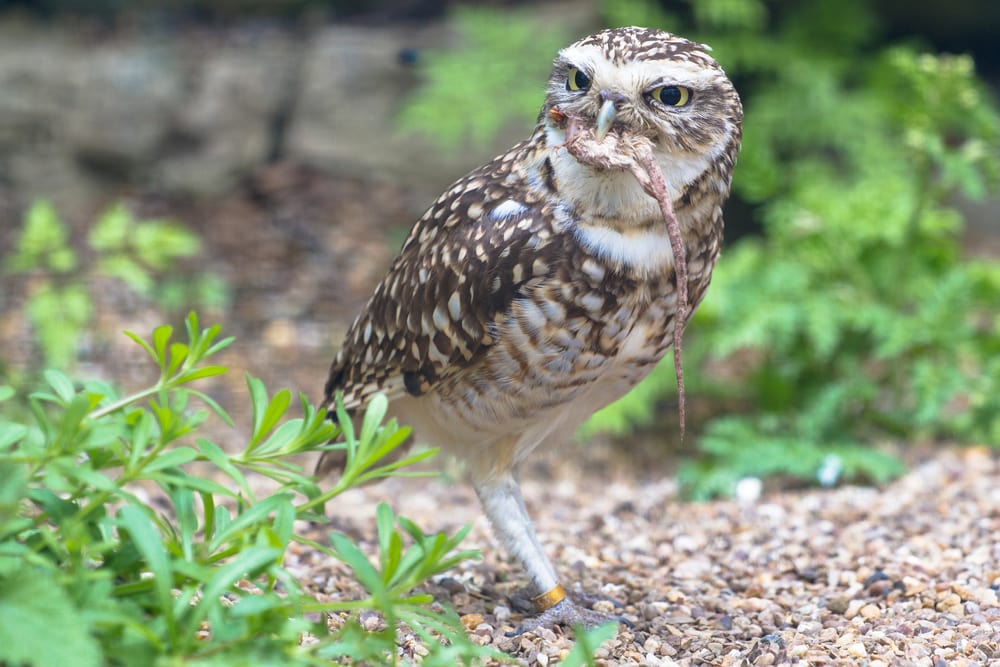
In North America, there is one species of owl that does not nest in trees and hunts small rodents. This is the burrowing owl, listed as endangered in Manitoba, Canada.
Because they are ground-based, burrowing owls feed primarily on insects such as beetles, dragonflies, and grasshoppers.
The pellet of a burrowing owl can be quite shiny with the castoff exoskeletons of consumed insects.
Facing imminent extinction, there were once 96 recognized pairs in the 1980’s, but there were only 1 pair in 1996.
In Alberta and Saskatchewan, the population is estimated to be less than 1000 pairs.
Federally protected, the burrowing owl is most threatened by habitat loss but also by predators such as foxes, coyotes, badgers, raccoons, large birds of prey, and almost anything else that sees this small owl as a snack.
Diet and Lifestyle
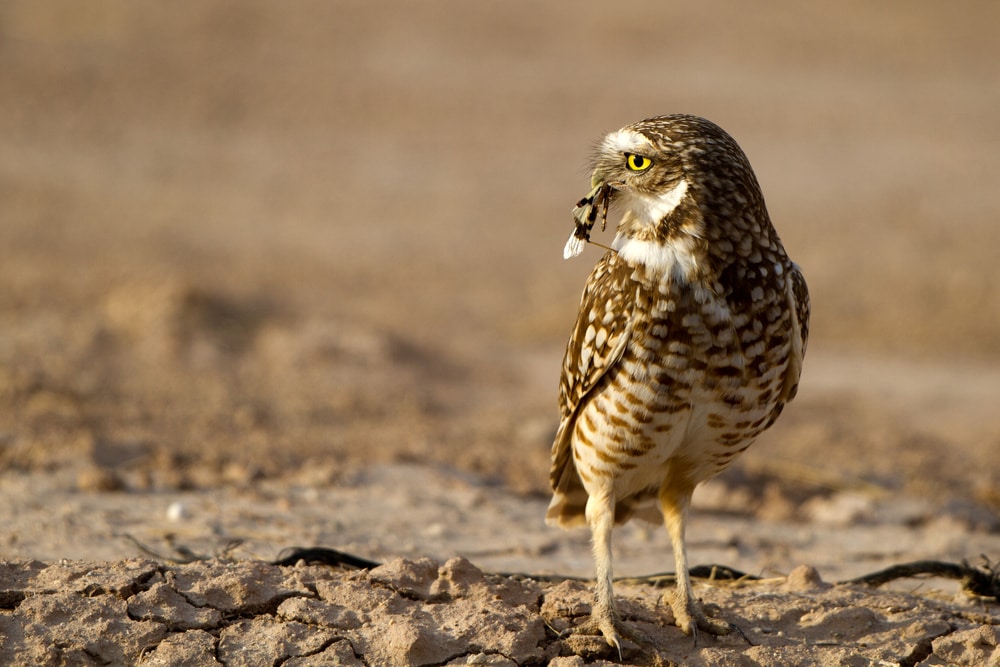
Owing to the fact that so much of their diet depends on insects, these owls are active during the day, often chasing their prey on foot. They also hunt at night, often catching snakes, salamanders, small rodents, and even ground squirrels smaller than themselves.
Once the male burrowing owl has found a mate, he locates a suitable tunnel and lines it with dried plants, feathers, and dried shredded cow manure.
Before you start to question his housekeeping skills, remember that manure (even dried) attracts insects. Dung beetles are known to be their favorite food.
Not only will this bring food right to their doorstep, but it also serves to mask the smell of the owls, providing them with a form of protection from predators as well.
Then the female takes over and builds a nest. Due to small lodgings, the male usually takes up residence in a different, nearby burrow. Both males and females feed the chicks, despite their unique living arrangements.
Storing Food
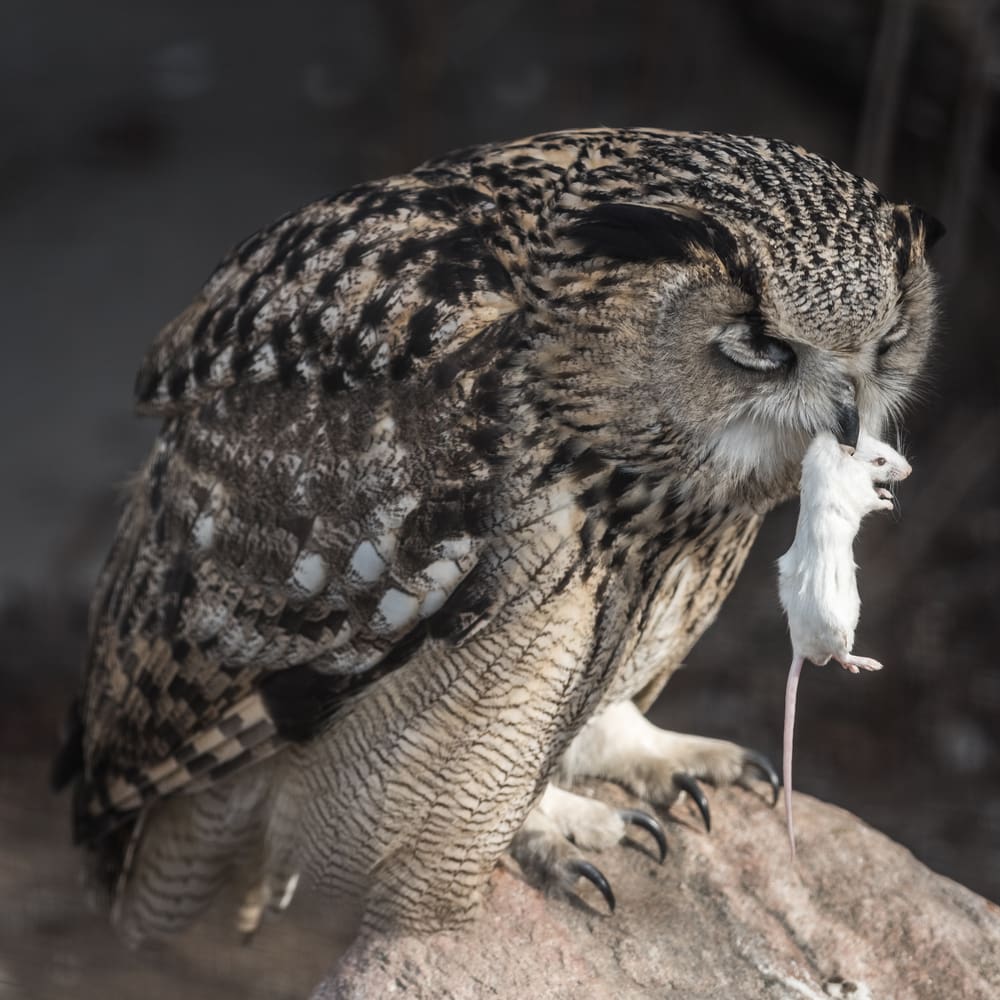
Unlike other species of owls, the burrowing owl has been known to store food during nesting season.
This is an important adaptation since the female will stay down in the burrow while incubating her eggs, not leaving until the chicks are two to three weeks old.
The male will hunt and bring food down into the burrow. In seasons when prey is abundant, burrows can contain up to several hundred food items.
Another adaptation to their home of choice is that burrowing owls can tolerate higher levels of carbon dioxide due to their tunnels lacking airflow.
Due to their diet of choice being insects, burrowing owls begin breeding in the spring. This ensures that when the chicks hatch, the insect population is at its peak. The chicks fledge and are mature enough to migrate by the time summer comes to a close.
Can Owls Vomit?
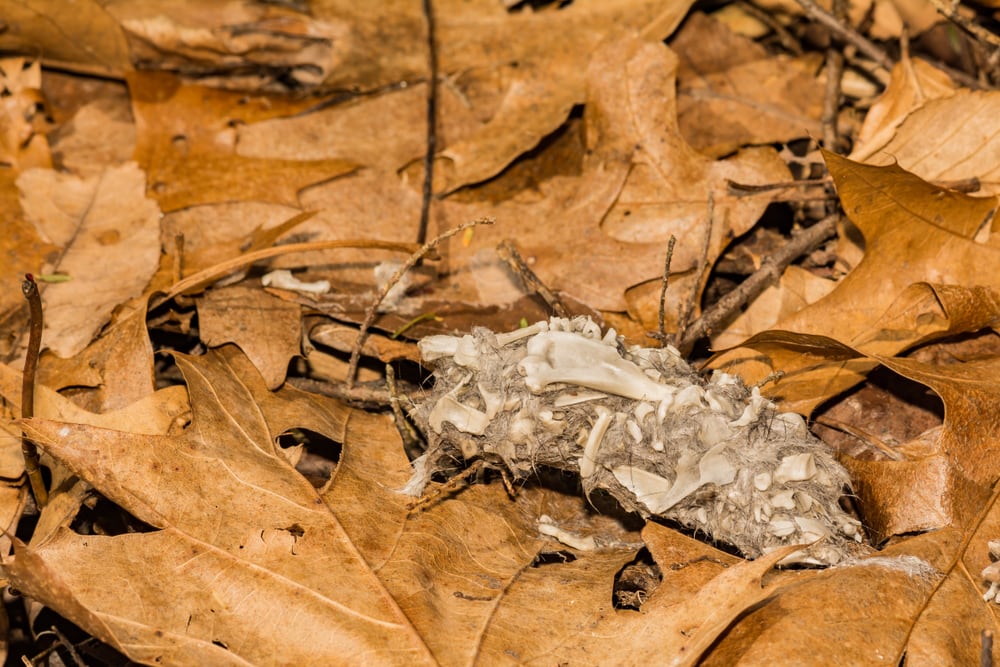
The hard-to-digest parts like feet, feathers, beaks, teeth, fur, or bones remain in the filter-like gizzard, where the material is compressed. As many as ten hours later, the owl vomits this material up.
This material is known as a “pellet” and tells scientists quite a lot about where the owl hunts and food availability.
Because the undigested material sits in the proventriculus for so long, the owl must purge this pellet before it can feed again.
Unlike a cat or dog, there’s no drama involved when an owl has to vomit. It simply takes on an uncomfortable expression, cranes its neck, and coughs up a pellet. There is no retching or noise.
You May Also Like: Are Bats Blind? Discover The Fascinating World Of Bat Senses
Did You Know?
- A group of owls is not called a flock, as you might expect, but a parliament.
- The Iñupiat people who live in the Arctic call the Snowy owl “Ukpik.”
- The oldest Great Horned Owl on record is a captive 50-year-old female, while the lifespan of an owl in the wild is approximately 20-30 years.
- Owls begin courtship behavior in late autumn, resulting in more vocalizations, activity, and sightings
- Young Snowy owl males get whiter as they age.
- The eyes of some North American owls are bright yellow or brown, while the eyes of some European owls are orange.
What Do Owls Eat FAQs
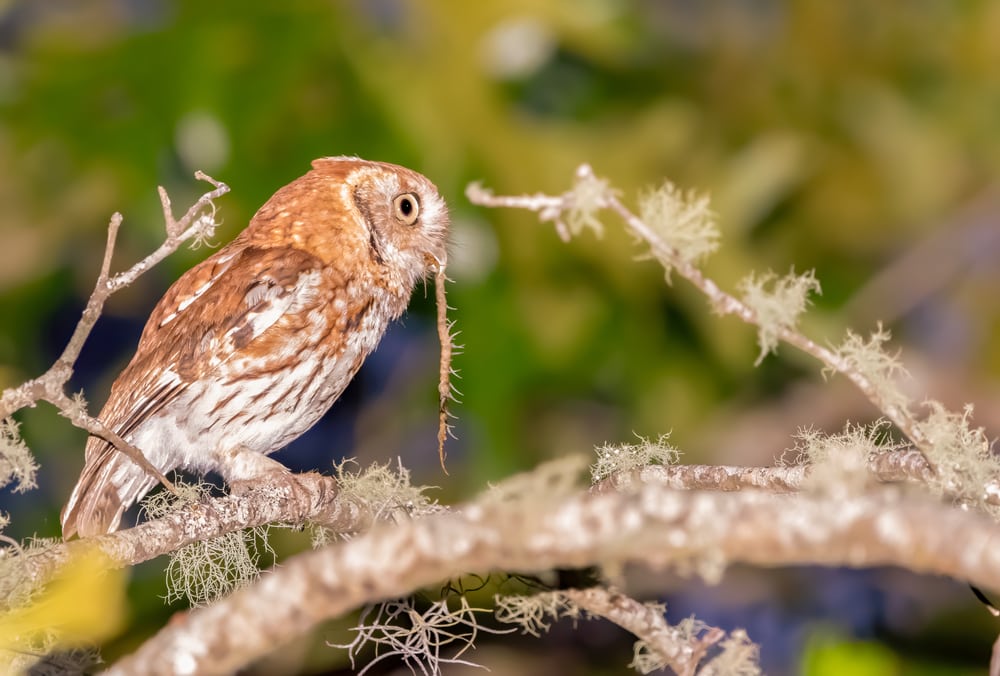
What is the role of owls in pest control?
Owls play a crucial role in controlling pests, as they primarily feed on rodents and insects. By preying on these creatures, owls can help keep their populations in check, benefiting the ecosystem.
Why do owls need to hunt both prey and scavenger food?
As opportunistic carnivores, owls are adapted to take advantage of whatever food sources are available in their environment. This ensures their survival in various conditions and habitats, making them versatile hunters who can shift from hunting live prey to scavenging when necessary.
How do the sizes of different owl species affect their diet?
The size of the owl species can significantly impact their diet, as larger owls are capable of preying on larger animals.
For instance, smaller owls might mainly feed on insects and small rodents, while larger owls could potentially prey on larger birds, reptiles, or even small mammals.
Do owls consume vegetation or fruit?
Owls are carnivores, which means their diet consists solely of other animals. They do not consume vegetation or fruit as part of their diet.
How does the habitat of an owl influence its diet?
The habitat of an owl significantly influences its diet, as different environments offer different types of prey.
For instance, those in forested environments might feed more on small mammals and birds, while those near rivers and lakes might have more fish in their diet. Desert-dwelling owls, on the other hand, might rely more on insects and small reptiles.








